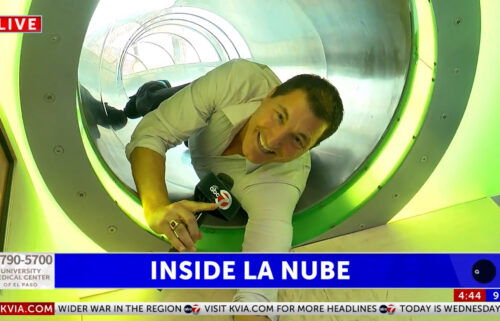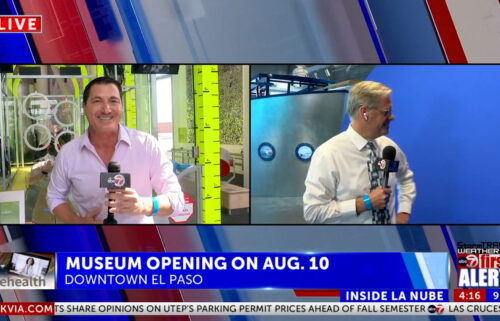It’s been an unusual path, but Jasmine Huda is where she wants to be
Click here for updates on this story
ST. LOUIS (St. Louis Post-Dispatch) — In high school, Jasmine Huda was not good at science. She needed to boost her physics grade when she was a junior, so she took on an extra-credit assignment.
She and a classmate at Ladue Horton Watkins High School went to Lambert airport to conduct experiments about velocity. They videotaped items on the moving sidewalk with a camcorder, and she recorded an introduction and a conclusion to the project.
A few days later, the teacher told her — in front of the class — “Jasmine, your presentation was great. You have an excellent future in communications. But your equations were wrong.”
The teacher, the late Jim Harpel, was prophetic: Huda is now an award-winning television journalist and anchors the 11 p.m. news at KTVI — Fox 2.
And she still doesn’t understand physics.
By her own admission, the path Huda’s professional career has taken has been both unconventional and a little bizarre.
The traditional route for news reporters is to learn their craft by starting out at a small station in a small market. Then they move on to progressively bigger stations in bigger cities. If they are ambitious enough and talented enough, they will end up in a city the size of St. Louis or larger. Only from there do a select few make it to a national network.
Not Huda. Though she wasn’t reporting, her career began on the national level — and for two of the most ideologically opposed institutions, National Public Radio and the Fox News Channel.
Huda grew up in Frontenac, the youngest of five children. Her parents, who had an arranged marriage, immigrated to the United States from small villages in India. Her father went to medical school there and became an ophthalmologist before the couple moved to St. Louis.
Huda played sports as a child — “I wasn’t very good, but I had a lot of fun,” she says — but found her calling in high school while on the speech and debate team. One of her favorite speech-and-debate events was radio news speaking, in which the students had to write and deliver a five-minute newscast.
“I was getting a feel for why the sentences are constructed the way they are, getting a feel for why they emphasize certain words. I really liked being able to zero in on the storytelling, even if it was just a 45-second story on what the president was doing,” she says.
The research and the hard work paid off. Her junior year, she came in seventh in the state in radio news speaking. Her senior year, she was the state champion.
Even so, she was not necessarily set on making broadcast news her career. She went to the University of Michigan, which does not have a broadcast news department, and became a political science major.
She excelled her first two years, but as a junior she became listless and lost. Her heart wasn’t into her work; her grades slipped.
“It took some real soul-searching to recognize that I wasn’t allowing myself to be what I wanted to be. To pursue my real interests. Once I accepted what was happening, it all made sense, and things started to move in a great direction,” she says.
That is when she went into the offices of the NPR affiliate in her college town, Ann Arbor, Michigan, and asked if they would consider giving her an internship. They agreed, and her life was changed.
“I got hands-on experience in my field, and at an NPR affiliate. It doesn’t get much better than that,” she says.
Still, Huda did not have a job offer in hand when she graduated, though she had sent out numerous applications. She was literally in the process of moving out of her apartment when she got an email from National Public Radio headquarters in Washington, D.C., asking if she were interested in an internship at “All Things Considered.” They wanted to interview her that day.
She got the job and found an English basement apartment to share with a roommate in the trendy neighborhood of Georgetown. She was ready to fly to Washington and had an informative phone conversation with the man who ran the show about what she needed to know about working there.
That was Sept. 10. The next day was Sept. 11, 2001.
“My flight kept getting delayed, because everything was shut down. I think I got there Sept. 17, and the next day I started,” she says.
One of the best parts about working at NPR was getting to meet all of the people whose work she had long admired.
“The one I was most excited about was Robert Siegel. I had been listening and recording his newscasts for so long. I remember sweating profusely. He was very nice,’” she says.
After the internship ended, she had a temporary stint as an editorial assistant at “Morning Edition,” but a permanent job at NPR was hard to find. She described her predicament to Juan Williams, who was working at both NPR and Fox News Channel at the time, and he asked if she would be interested in working in television. “It was a culture shock, and not just (the change from) the medium of radio to TV. This was a 24-hour cable news network. It was very cutthroat. A lot of the things you hear about that place are true.
“I did not know what I was getting into. I really didn’t. I knew it would be fast-paced, intense. It was just not what I expected, for someone who was in her early 20s,” she says.
Huda worked on the booking desk at Fox, securing guest commentators and pundits to be panelists on the daytime news shows. She was there when Saddam Hussein was captured and when Ronald Reagan died, which happened during a G-8 summit in Savannah, Georgia. She was in Savannah trying to book people to come talk about Reagan.
“I learned a lot from my experience there. I’ve learned a lot from every workplace. There it was how to juggle 800 things at once, when you’re putting together different segments, when you’re under deadline pressure,” she says.
Years later, her supervisor at the time, Laurie Luhn, said that she had been sexually harassed by Fox News CEO Roger Ailes for 20 years, including the time that Huda worked there.
“I can’t believe that I was part of that environment,” she says. “A lot was happening that I didn’t know about.”
Huda came back to St. Louis and was soon hired by a station in Springfield, Missouri. There, she made the mistakes that beginning reporters make, and learned how to avoid them. She learned how to handle the pressure of deadlines and to manage her time, and she also picked up countless tips from veteran reporters and photographers, particularly at the Springfield News-Leader newspaper.
After two years, she headed back to St. Louis and worked for KSDK (Channel 5) and KMOV (Channel 4) before finding a home at KTVI in 2016.
They are glad to have her.
“Jasmine is fantastic to work with. She’s been a do-everything employee for us. Everything I put her on, she does great at. She’s just a very versatile anchor-reporter,” says Kurt Krueger, the station’s vice president and general manager.
“She is tenacious in that she goes in-depth into a story. And her personality — people like her, so they open up to her. She is able to go beyond the standard reporter role and connect with everybody,” he says.
It is the reporting part of her job that makes Huda stand out. Most anchors no longer work as reporters, but she actively seeks out her own stories to report.
“You can tell the (anchors) that are reporters at heart. I think it comes across in your delivery and your knowledge of the stories,” Huda says.
Some of the stories she now covers come from sources she made while reporting over the years.
In one recent story, she covered a beloved pediatric physician at SSM Cardinal Glennon Children’s Hospital, Nadeem Qureshi, who contracted COVID and was hospitalized for weeks. When he was finally released, people he worked with and the families whose lives he had touched threw him a surprise welcome-home parade.
“It was such a beautiful story to me. I watched the video of these people, and it made me cry. Seeing his reaction, and all these people. You know, it’s not the action, it’s the reaction. It was so sweet,” she says.
The idea for the story came from the doctor’s former nurse, Peggy Snyder. Snyder is also the mother of St. Louis County Police Officer Blake Snyder, who was killed in the line of duty in 2016. Huda covered Blake Snyder’s death, and she and Peggy Snyder have kept in touch over the years.
KTVI news director Audrey Prywitch says: “Families reach out to Jasmine for a reason when a loved one is killed in the line of duty. Each one is unique, and she takes the time to honor the office; it’s not a cookie-cutter approach.
“She feels their loss deeply, and she is able to create fitting tributes. She is able to make each one fitting and unique.”
The job is stressful, and Huda spends much of her time away from the anchor desk working for an assortment of charities as a way of giving back to the community. Both of her parents have heart disease, so she spends most of her charitable time with the American Heart Association, especially the Go Red for Women program. She also works with the BackStoppers and other organizations, including the National Council of Jewish Women’s Back 2 School Store.
In order to lessen the stress, Huda turns to yoga almost every day. She first tried it at a bachelorette weekend, which was a difficult environment in which to fully appreciate the activity. But she was interested enough to try it at her gym, and now she is hooked.
“A lot of people think it’s just about stretching, but I take a lot of very intense classes, heated yoga or power yoga classes that leave you drenched. I get a physical workout, but I also get one for my brain. It clears the clutter in my brain. It sets the day off really well, and I recommend everyone try it,” she says.
“It sounds cheesy, but I feel like it gives me physical and emotional strength at the same time.”
At the end of a class a few years ago, one of her yoga instructors shared a quote by Yung Pueblo that Huda says “really resonated with me.” She even saved it on her phone’s home screen; she calls it “insightful, poetic and powerful.”
The quote is: “True power is living the realization that you are your own hero, healer and leader.”
Please note: This content carries a strict local market embargo. If you share the same market as the contributor of this article, you may not use it on any platform.




